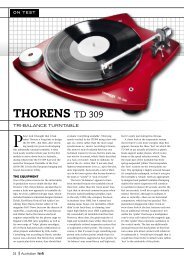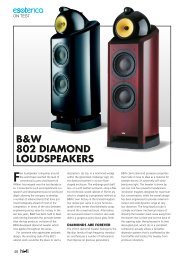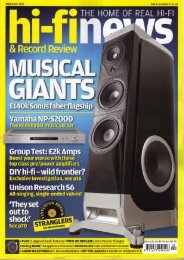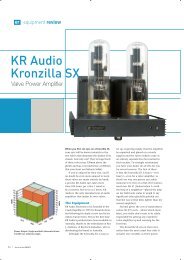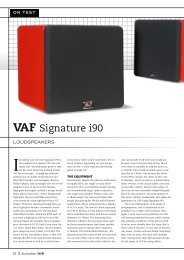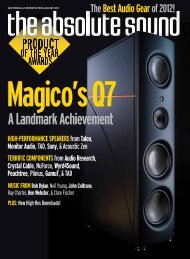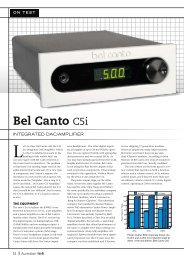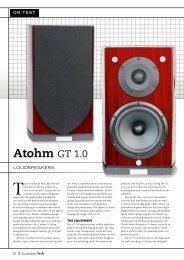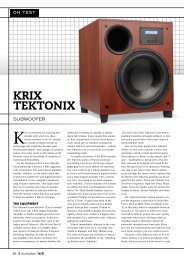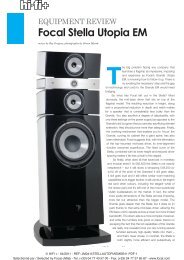here - Ultra High-End Audio and Home Theater Review
here - Ultra High-End Audio and Home Theater Review
here - Ultra High-End Audio and Home Theater Review
Create successful ePaper yourself
Turn your PDF publications into a flip-book with our unique Google optimized e-Paper software.
O N T E S T<br />
ORPHEUS<br />
APOLLO VI<br />
LOUDSPEAKERS<br />
Orpheus has gone back to its roots<br />
with its Apollo VI floor-st<strong>and</strong>ing<br />
speakers. Gone are the curved<br />
cabinets. Gone are the Kevlar<br />
drivers…with the Apollo VI, what you get is a<br />
basic, three-driver, two-way speaker system.<br />
A Change of Heart<br />
The catalyst for this ‘back to basics’ design<br />
was when Kiat Low, of Orpheus, was told by<br />
his cabinet-maker that he could expect the<br />
price of his cabinets to increase dramatically.<br />
Although the price increases do not affect<br />
Orpheus’s high-end designs, because the<br />
cost of the cabinet is a smaller portion of the<br />
overall cost, because of the far-higher costs of<br />
the drivers <strong>and</strong> crossover networks, the result<br />
was that Low decided he could no longer use<br />
curved cabinets to build Orpheus’ more inexpensive<br />
models if they were going to remain<br />
inexpensive.<br />
When I asked Low why other manufacturers<br />
were still offering curved cabinets in their<br />
‘budget’ lines, he told me that before I asked<br />
him that question I should have checked out<br />
the cabinets made by his competitors more<br />
closely. He says that many of the curved cabinets<br />
on sale in showrooms are curved simply<br />
because the manufacturer has ‘rounded off’<br />
the sides of outside panels with a belt s<strong>and</strong>er.<br />
He told me that if I looked inside these cabinets,<br />
I’d discover that all the internal surfaces<br />
were completely flat. ‘All our curved cabinets<br />
use properly pre-stressed curved panels, so that<br />
the inside cabinet walls are just as curved as the<br />
outside walls,’ he told me. ‘This is the only way<br />
you can get an acoustic benefit from curves.’<br />
This certainly explained the ‘return to<br />
rectangular’ approach for the Apollo VI<br />
design, but not the reason for ditching Kevlar-coned<br />
drivers in favour of paper. It turns<br />
out that the reason for this change was more<br />
complex. Low says it was partly because the<br />
return to a rectangular cabinet entailed not<br />
so much a ‘re-design’ as going back to scratch<br />
<strong>and</strong> starting all over again <strong>and</strong> this meant reevaluating<br />
all the new drivers that have come<br />
onto the market since Orpheus switched to<br />
Kevlar. Then t<strong>here</strong> was the fact that although<br />
he was happy with the performance of<br />
Kevlar, Low continues to reminisce about the<br />
sound of paper-coned drivers. ‘Paper [cones]<br />
offers a warmer sound signature,’ he said in a<br />
recent interview. ‘One that was reminiscent of<br />
Orpheus before Orpheus went the Kevlar path.’<br />
The new bass/midrange driver Orpheus<br />
has selected for use in the Apollo VI has a cast<br />
aluminium chassis, an absolutely enormous<br />
centre-vented magnet <strong>and</strong> an exposed motor<br />
system with under-suspension venting. Obviously,<br />
it has a paper cone, but the surround<br />
suspension is rubber, rather than the more<br />
old-fashioned foam, or the even-more-oldfashioned<br />
pleated fabric. My measurements<br />
of driver diameter put the overall driver as<br />
being slightly larger than Orpheus is claiming<br />
(I measured 180mm, w<strong>here</strong>as Orpheus claims<br />
178mm) which is contrary to what I usually<br />
find, with most manufacturers trying to gild<br />
the lily by overstating the size of their drivers.)<br />
However, it’s the Thiele/Small diameter<br />
that’s the most important, <strong>and</strong> I measured<br />
this as being 130mm, which means the effective<br />
cone area works out to be 133cm². (This<br />
is important because cone area is one of the<br />
two factors that dictate of how much air will<br />
be moved when the cone moves, the other<br />
factor being the distance the cone can move<br />
back <strong>and</strong> forth, known as excursion.)<br />
Orpheus is using two drivers in the Apollo<br />
VI, so the total cone area available is 266cm².<br />
Using two drivers is the usual way to increase<br />
the cone area, but the increase is not as large<br />
as most people think. In fact, what most<br />
people think is that the single cone would<br />
have to be twice the diameter of one of the<br />
smaller drivers, which is not true. In fact, if<br />
Orpheus had wanted to have the same total<br />
cone area, but wanted to use only a single<br />
driver, rather than two drivers, that single<br />
driver would require an overall diameter of<br />
only 234mm in order to have the same cone<br />
area—which means an increase in diameter<br />
of only 25 per cent.<br />
The Apollo VI’s tweeter has a fairly<br />
large-diameter (30mm) pure silk dome that<br />
is enclosed within a very large roll surround<br />
that takes the overall moving diameter up to<br />
42mm. It’s driven by an equally large ferrite<br />
magnet.<br />
Inside the cabinet, the crossover network<br />
is complex, with 15 elements in all, comprising<br />
twelve MKP capacitors, five resistors (four<br />
of which are metal-film), <strong>and</strong> four air-cored<br />
inductors, all of which are cross-mounted so<br />
t<strong>here</strong> is no possibility of any unwanted interaction<br />
between them. Although the crossover<br />
is implemented via a PCB rather than being<br />
hard-wired, the PCB has very thick, wide<br />
30 Australian
Orpheus Apollo VI Loudspeakers<br />
O N T E S T<br />
copper tracks. This theme is continued with<br />
the internal cabling, which is all Wireworld<br />
MiniEclipse 5², a wire design that comprises<br />
non-str<strong>and</strong>ed flat copper conductors (16awg -<br />
1.25mm²) encapsulated in circular insulation<br />
sheaths The cables are soldered to both the<br />
crossover network <strong>and</strong> the driver terminals.<br />
Orpheus has evidently put a lot of<br />
thought <strong>and</strong> work into its ‘new’ non-curved<br />
cabinet, so that it varies in thickness from<br />
18mm to 25mm depending on the panel<br />
location <strong>and</strong> is heavily internally braced. I<br />
counted three different types of foam used internally.<br />
The bass reflex port, which is located<br />
on the front baffle <strong>and</strong> t<strong>here</strong>fore simplifies<br />
speaker placement, is curiously short (70mm)<br />
<strong>and</strong> 65mm in length. The speakers Orpheus<br />
supplied for our review were its showroom<br />
samples <strong>and</strong> were finished in black oak<br />
veneer—the veneer being real timber, rather<br />
than a vinyl. I liked the black oak finish, <strong>and</strong><br />
our photographer took some nice images of<br />
them, but when I saw the photos Orpheus<br />
supplied, which were of the same model<br />
finished in Mahogany (the other available<br />
veneer), I immediately knew which finish I<br />
preferred, so I’ve used Orpheus’ stock photographs<br />
to illustrate this review. Each cabinet<br />
measures 980×220×325mm (HWD).<br />
Listening Sessions<br />
The Orpheus speakers are very ‘room-friendly’<br />
because of the location of their drivers<br />
on the front baffle, <strong>and</strong> the fact that the<br />
port is also on the front baffle. Even better,<br />
I found that—at least in my room—they<br />
sounded most impressive when they were<br />
pushed back almost touching the wall. Yes, I<br />
could get more ‘air’ around the highs when I<br />
moved the speakers about a metre out from<br />
the room, but I preferred the increase in bass<br />
from having them closer to the wall.<br />
I think you’ll notice the quality of the<br />
bass from the moment you start auditioning,<br />
because it’s very much ‘t<strong>here</strong>’—so much<br />
‘t<strong>here</strong>’ that it was, perhaps, just a tad forward<br />
in my listening room, but as I pointed out,<br />
that was my choice. If I’d moved the speakers<br />
further away from the wall it would have<br />
balanced out the bass nicely—I just chose<br />
not to. Either way, the actually quality of the<br />
bass is excellent. It’s fast, tight <strong>and</strong> exciting,<br />
with absolutely no ‘honk’ or other upper-bass<br />
colourations audible. The low-frequency extension<br />
Orpheus has achieved is exceptional<br />
considering the relatively small size of the<br />
drivers <strong>and</strong> the enclosure. Those super-light<br />
paper cones <strong>and</strong> large driving magnets are<br />
obviously delivering big-time!<br />
The light-weight cones have also allowed<br />
Orpheus to run the bass/midrange drivers up<br />
higher in frequency than synthetic cones,<br />
which has meant that despite being a true<br />
two-way design, the midrange is tonally<br />
identical to the bass. The midrange also<br />
turned out to be very smooth, most noticeably<br />
so when reproducing vocals, which were<br />
rendered gloriously. If you’re a fan of choral<br />
music, or a capella vocal ensembles, you’ll<br />
love the Apollo VIs.<br />
<strong>High</strong>-frequency performance was very<br />
good too, though I’d add the proviso that<br />
you should angle the speakers so they face<br />
the listening position, as the tweeter gives of<br />
its best when you’re on axis. This means you<br />
should also tilt the speakers if necessary to<br />
get the tweeters aimed at ear-height (easily<br />
done with spikes). One advantage of the<br />
large tweeter dome was that I could play back<br />
music at very high levels for extended periods<br />
yet still have the tweeter delivering the full<br />
quotient of high-frequency information.<br />
Smaller tweeters, which often have inadequate<br />
heat dissipation, mostly lose their efficiency<br />
under such situations, resulting in a<br />
reduction in the level of the high frequencies.<br />
However, I should also note that I did have<br />
to keep a weather eye on volume levels when<br />
playing the Apollo VIs. Although they will<br />
happily play very loudly with almost all types<br />
of music, I did find that with orchestral works<br />
I needed to lower the volume somewhat to<br />
ensure maximum clarity.<br />
I was also pleased to find the Apollo VIs<br />
are as amplifier-friendly as they are roomfriendly.<br />
During the course of the review,<br />
which had them linked to any number of<br />
amplifiers variously rated between 60-watts<br />
per channel <strong>and</strong> 180-watts per channel, I also<br />
trialled them with the lowest-powered amplifier<br />
I had on h<strong>and</strong> (10-watts!) as well as with<br />
a budget 40-watt home theatre receiver <strong>and</strong><br />
the Apollo VIs performed very nearly<br />
as well with these low-powered units<br />
as they had with the high-powered<br />
high-end amplifiers I used.<br />
Conclusion<br />
T<strong>here</strong>’s no getting around it, Orpheus’s<br />
Apollo VI speakers are beautifully crafted,<br />
<strong>and</strong> the result of this is that they sound ‘just<br />
right.’ Give them an audition <strong>and</strong> I am sure<br />
you will agree! greg borrowman<br />
ORPHEUS APOLLO VI<br />
LOUDSPEAKERS<br />
Br<strong>and</strong>: Orpheus<br />
Model: Apollo VI<br />
Category: Floorst<strong>and</strong>ing Loudspeakers<br />
RRP: $2,000<br />
Warranty: Five Years<br />
Distributor: Orpheus Loudspeakers<br />
Address: Unit 4, 26 Stanley Street<br />
Peakhurst NSW 2210<br />
(02) 9584 1822<br />
(02) 9584 1708<br />
info@orpheusaudio.com.au<br />
www.orpheusaudio.com.au<br />
• Great bass<br />
• Very efficient<br />
• Easy to drive<br />
• Limited number of<br />
cabinet finishes<br />
• Rectangular<br />
LAB REPORT<br />
cabinet design<br />
Readers interested in a full technical<br />
appraisal of the performance of<br />
the Orpheus Apollo VI Loudspeakers<br />
should continue on <strong>and</strong> read the<br />
LABORATORY REPORT published on<br />
page 101. Readers should note that<br />
the results mentioned in the report,<br />
tabulated in performance charts <strong>and</strong>/<br />
or displayed using graphs<br />
<strong>and</strong>/or photographs should<br />
be construed as applying only<br />
to the specific sample tested.<br />
Lab Report on page 101<br />
avhub.com.au<br />
31
L A B R E P O R T<br />
Orpheus Apollo VI Loudspeakers<br />
CONTINUED FROM PAGE 30<br />
110<br />
105<br />
100<br />
110<br />
105<br />
100<br />
95<br />
90<br />
85<br />
80<br />
75<br />
70<br />
65<br />
60<br />
55<br />
95<br />
90<br />
85<br />
80<br />
75<br />
70<br />
65<br />
60<br />
55<br />
dBSPL<br />
Newport Test Labs<br />
50<br />
20 Hz 50 100 200 500 1K 2K 5K 10K<br />
Graph 1. Averaged frequency response using pink noise test stimulus with capture<br />
unsmoothed (red trace) <strong>and</strong> smoothed to one-third octave (blue trace). Both traces are the<br />
averaged results of nine individual frequency sweeps measured at three metres, with the<br />
central grid point on-axis with the tweeter. [Orpheus Apollo IV Loudspeaker]<br />
dBSPL<br />
Newport Test Labs<br />
50<br />
400 Hz 500 1K 2K 5K 10K 20K 30K<br />
110<br />
105<br />
100<br />
40<br />
30<br />
20<br />
10<br />
95<br />
90<br />
85<br />
80<br />
75<br />
70<br />
65<br />
60<br />
55<br />
Graph 2. <strong>High</strong>-frequency response, exp<strong>and</strong>ed view, with grille on (red trace) vs grille off<br />
(green trace). Test stimulus gated sine. Microphone placed at three metres on-axis with<br />
dome tweeter. Lower measurement limit 400Hz. [Orpheus Apollo VI Loudspeakers]<br />
dBSPL<br />
Newport Test Labs<br />
50<br />
10 Hz 20 50 100 200 500 1K 2K<br />
9<br />
8<br />
7<br />
6<br />
5<br />
4<br />
Test Results<br />
The Orpheus Apollo VI exhibited flat <strong>and</strong><br />
extended responses according to the measurements<br />
performed by Newport Test Labs.<br />
Overall, the laboratory reported the Apollo<br />
VI’s tested response as extending from 35Hz<br />
to 29kHz ±3dB. The lab also put the Apollo<br />
VI’s sensitivity at a very high 90.5dBSPL,<br />
which is excellent. It’s worth mentioning that<br />
this exactly matches Orpheus’ specification,<br />
which demonstrates that Orpheus is being<br />
very ‘real-world’ (aka ‘honest’) about its specifications,<br />
since very few speakers meet their<br />
claim for this specification. The same goes for<br />
the nominal impedance, which Orpheus has<br />
correctly stated as being 4Ω.<br />
Graph 1 shows the in-room response of<br />
the Orpheus Apollo VI. On this graph, the<br />
red trace shows the unsmoothed average of<br />
nine different traces, while the blue trace<br />
Graph 3. Low frequency response of front-firing bass reflex port (red trace) <strong>and</strong> woofer.<br />
Nearfield acquisition. Port/woofer levels not compensated for differences in radiating areas.<br />
Ohm<br />
3<br />
-180<br />
10 Hz 20 50 100 200 500 1K 2K 5K 10K 20K 30K<br />
Deg<br />
Newport Test Labs<br />
Graph 4. Impedance modulus of left (red trace) <strong>and</strong> right (yellow trace) speakers plus<br />
phase (blue trace). Black trace under is reference 4 ohm precision calibration resistor.<br />
180<br />
150<br />
120<br />
90<br />
60<br />
30<br />
0<br />
-30<br />
-60<br />
-90<br />
-120<br />
-150<br />
simply shows the response after applying<br />
third-octave filtering to the<br />
averaged response. You can see<br />
that between 40Hz <strong>and</strong> 10kHz the<br />
frequency response varies by no<br />
more than 1.5dB. The overall<br />
response is balanced across the<br />
audio spectrum, though it<br />
favours the low-frequencies<br />
just a little. T<strong>here</strong> are two<br />
shallow dips in the measured<br />
response, one between 100Hz<br />
<strong>and</strong> 300Hz <strong>and</strong> the other<br />
between 1.5kHz <strong>and</strong> 3.5kHz.<br />
I’d expect both of these to ‘flavour’<br />
the sound, but they would<br />
certainly not detract from the<br />
overall smoothness of the sound.<br />
The high-frequency extension<br />
of the tweeter is shown in<br />
Graph 2. You can see that it rolls<br />
off a little above 10kHz, then picks<br />
up above 20kHz before rolling off<br />
sharply immediately prior to 30kHz.<br />
This graph, which is completely<br />
unsmoothed, shows a deeper ‘suckout’<br />
across the region 1.5kHz to<br />
3.5kHz, but this is largely a function<br />
of the microphone having to be just<br />
Newport Test Labs<br />
reported the Apollo VI’s<br />
response extended from<br />
35Hz to 29kHz ±3dB<br />
<strong>and</strong> that the speakers’<br />
sensitivity was a very high<br />
90.5dBSPL...<br />
1 metre from the tweeter in order to make<br />
this particular measurement, which for the<br />
driver layout used on the Apollo VI results in<br />
a degree of cancellation that would not (<strong>and</strong><br />
in fact does not, as you can see in the other<br />
graphs) occur in the far-field. However, even<br />
with this ‘suck-out’, the response across the<br />
region 400Hz to 25kHz is still an excellent<br />
±4dB. This trace also shows that Orpheus<br />
has done a magnificent job with the design<br />
of the speaker grille: it’s almost completely<br />
acoustically transparent, which means you<br />
won’t hear any difference in sound no matter<br />
whether the grille is on or off.<br />
Low-frequency measurements show the<br />
bass/midrange driver(s) are flat down to<br />
85Hz, after which they roll off at 18dB per<br />
octave. The port kicks in to deliver its maximum<br />
output at 45Hz, but it has significant<br />
output from around 25Hz right up to around<br />
150Hz. T<strong>here</strong> is some unwanted output from<br />
the port up around 500Hz <strong>and</strong> 1.5kHz, but<br />
it’s at very low levels, so would have very<br />
little effect on overall sound.<br />
The impedance graph shows that pair<br />
matching of the left <strong>and</strong> right speakers was<br />
good without being exceptional, <strong>and</strong> our<br />
pair was a demonstrator pair, so they’ve<br />
likely been shifted around a lot, which may<br />
have dislodged some of the internal acoustic<br />
fill. The impedance for the most part stays<br />
above 5Ω, but dips to 4Ω at 200Hz <strong>and</strong> to<br />
3.5Ω at 18kHz. It’s this upper dip that earns<br />
the Apollo VI its ‘nominal’ rating of 4Ω, but<br />
mostly the speaker will present as a 5Ω load<br />
to the driving amplifier. The trace reveals<br />
some small cabinet resonances at 150Hz <strong>and</strong><br />
330Hz, but they’re inconsequential.<br />
As I noted earlier, the Apollo VI’s sensitivity<br />
was measured by Newport Test Labs as<br />
being 90.5dBSPL at one metre, using a pink<br />
noise test signal at a level of 2.83Veq. This is<br />
an excellent result, which means the Apollo<br />
VI will extract maximum performance from<br />
even low-powered amplifiers. These are welldesigned<br />
loudspeakers. Steve Holding<br />
avhub.com.au<br />
101



